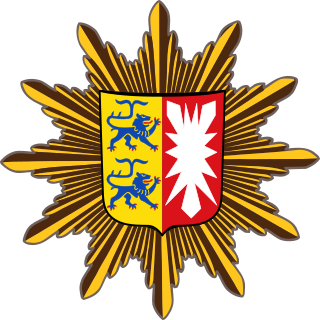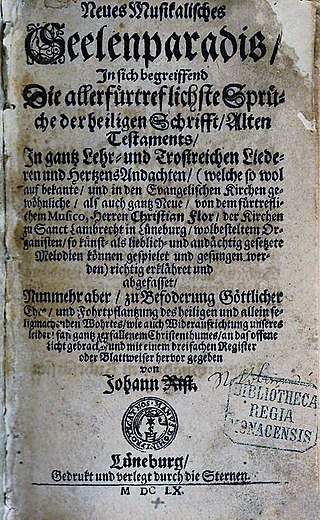
Bundesautobahn 1 is an autobahn in Germany. It runs from Heiligenhafen in Schleswig-Holstein to Saarbrücken, a distance of 749 km (465 mi), but is incomplete between Cologne and Trier. B 207 continues north from Heiligenhafen to Puttgarden, at the end of the island of Fehmarn, with a ferry to Rødby, Denmark.

The Reventlow family is a Holstein and Mecklenburg Dano-German noble family, which belongs to the Equites Originarii Schleswig-Holstein. Alternate spellings include Revetlo, Reventlo, Reventlau, Reventlou, Reventlow, Refendtlof and Reffentloff.

Schleswig-Holstein Police is a state law-enforcement agency in Schleswig-Holstein, Germany. It is subordinated to the Schleswig-Holstein Ministry of the Interior, Municipal Affairs, Housing and Sports.

Anna Constantia von Brockdorff, later the Countess of Cosel, was a German lady-in-waiting and noblewoman, and mistress of Augustus the Strong, King of Poland and Elector of Saxony, in 1706–1713. Eventually he turned against her and exiled her to Saxony, where she died after 49 years of internal exile.

Holstein Switzerland is a hilly area with a patchwork of lakes and forest in Schleswig Holstein, Germany, reminiscent of Swiss landscape. Its highest point is the Bungsberg. It is a designated nature park as well as an important tourist destination in Northern Germany situated between the cities of Kiel and Lübeck.

Wellingsbüttel Manor is a former manor with a baroque manor house in Hamburg, Germany, which once enjoyed imperial immediacy (Reichsfreiheit). Wellingsbüttel was documented for the first time on 10 October 1296. Since 1937 it has formed part of the suburbs of Hamburg as the heart of the quarter of the same name, Wellingsbüttel, in the borough of Wandsbek. The owners of Wellingsbüttel Manor from the beginning of the 15th until the early 19th century were consecutively the Archbishops of Bremen, Heinrich Rantzau, Dietrich von Reinking, the Barons von Kurtzrock, Frederick VI of Denmark, Hercules Roß, the Jauch family, Cäcilie Behrens and Otto Jonathan Hübbe. In the early 19th century it was the residence and place of death of Friedrich Karl Ludwig, Duke of Schleswig-Holstein-Sonderburg-Beck, the penultimate duke, who was an ancestor inter alia of the present-day British royal family. Wellingsbüttel Manor was elevated to the status of a Danish "chancellery manor" (Kanzleigut). It was then acquired by Grand Burgher of the Free and Hanseatic City of Hamburg Johann Christian Jauch junior (1802–1880), becoming a country estate of the Jauch family. The manor house is together with Jenisch House (Jenisch-Haus) one of Hamburg's best conserved examples of the Hanseatic lifestyle in the 19th century and jointly with the manor gatehouse a listed historical monument. The estate is located on the banks of the Alster River in the middle of the Alster valley (Alstertal) nature reserve.

Krummbek Manor is a manor house in the municipality of Lasbek. It is a listed historical monument.

Schloss Ahrensburg is a former Herrenhaus (mansion) and is today referred to as a Schloss. It is located in Ahrensburg in southern Schleswig-Holstein, Germany, not far from the city of Hamburg.

Christian Flor was a German composer and organist. Working at churches in Rendsburg and Lüneburg, he was widely known for vocal and organ compositions. He composed one of the earliest Passion oratorios, in 1667.

The von der Osten family [ ˈoːstən ] is an ancient and distinguished aristocratic family from Pomerania that has been established in Pomerania since 1248, originally from Stift Bremen. The family's ancestral home is in Lower Saxony, near the Oste River. The family acquired numerous properties in Western and Eastern Pomerania, becoming one of the largest landowners in Pomerania. In 1854, the von der Ostens were one of the first ten families to hold the hereditary right of presentation to the Prussian House of Lords.
This page is based on this
Wikipedia article Text is available under the
CC BY-SA 4.0 license; additional terms may apply.
Images, videos and audio are available under their respective licenses.









